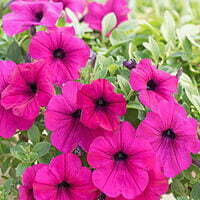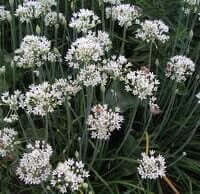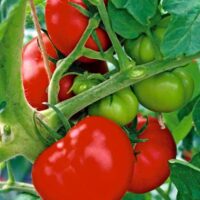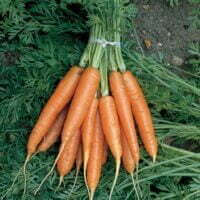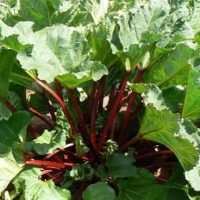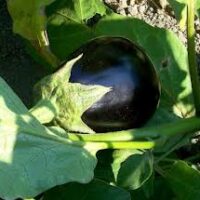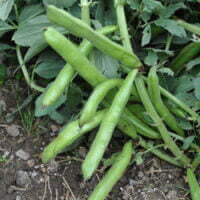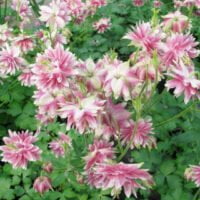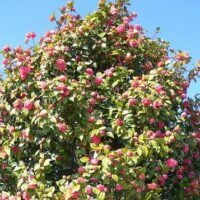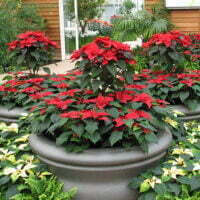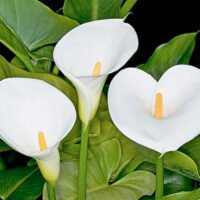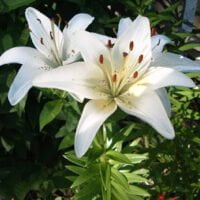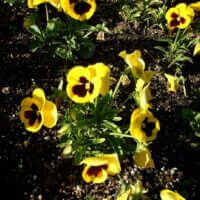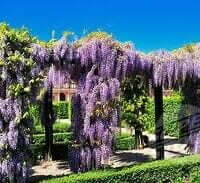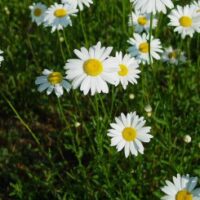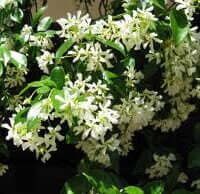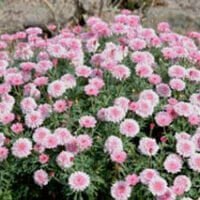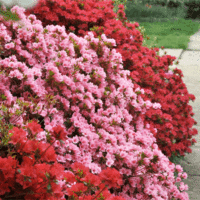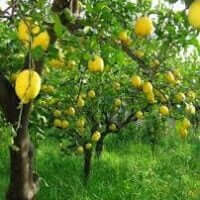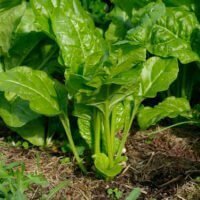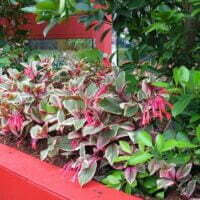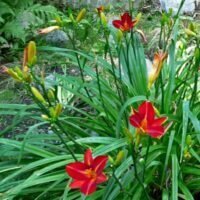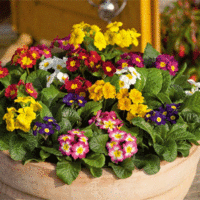What to do in the garden during October
October is a colourful and exciting time in the garden, be sure to take some time off and appreciate the beauty and relaxation your garden has to offer. As the temperature starts to rise it is important to keep the garden well watered. So water all shrubs and trees once a week especially during dry weather. Remember, a layer of mulch is always a good thing when it comes to retaining water and fighting off the weeds.
Plant and sow
Now is the time to plant if your garden is to boast during summer, take the time to research and choose your plants before buying as it is important to select the right plants for certain situations, positions and conditions.
Annuals
- Planting up a border en masse never ceases to amaze.
- Remember to keep the rest of our garden in mind when selecting a colour scheme.
- Summer annuals look great in both mixed and mono-coloured boarders and can even be used to create a focal point around containers and focal or specimen plants.
bedding plants to be planted now:
-
 Salvia officinalis (Sage)
Salvia officinalis (Sage) -
 Tagetes erecta (Marigold, african marigold)
Tagetes erecta (Marigold, african marigold) -
 Cosmos bipinnatus (Cosmos)
Cosmos bipinnatus (Cosmos) -
 Begonia Species (Begonia)
Begonia Species (Begonia) -
 Impatiens (Balsam, Busy lizzie, Water Fuchsia)
Impatiens (Balsam, Busy lizzie, Water Fuchsia) -
 Celosia argentea (Celosia, cock’s comb)
Celosia argentea (Celosia, cock’s comb) -
 Lobelia anceps (Angled lobelia)
Lobelia anceps (Angled lobelia) -
 Gaillardia aristata (Blanket flower)
Gaillardia aristata (Blanket flower) -
 Dianthus x hybrids (Carnation)
Dianthus x hybrids (Carnation) -
 Petunia spp (Petunia)
Petunia spp (Petunia)
Herbs & Vegetables
- More permanent crops to plant now in the vegetable garden are globe artichokes, chives and rhubarb.
- Jerusalem artichoke (Helianthus tuberoses) can also be planted now. They are frost hardy, quick growing, prefer full sun and tolerate a variety of soils. The tuber is edible and the attractive yellow flowers and growth habit make it an effective screening plant.
- Garlic can also be planted now, separate and plant them about 75 mm deep in well-drained fertile soil. Remove flowers as they appear and harvest once the foliage turns yellow.
- Follow these tips when sowing vegetables during October.
- Plant tomatoes, green peppers, brinjals and lettuce out from seed trays.
- Carrots and beans can also be planted now.
- Continue sowing salad crops, remember to sow in regular successions to ensure they mature in accordance with harvesting requirements.
-
 Allium sativum (Garlic)
Allium sativum (Garlic) -
 Allium schoenoprasum (Chives)
Allium schoenoprasum (Chives) -
 Lycopersicon esculentum (Tomatoes)
Lycopersicon esculentum (Tomatoes) -
 Lactuca sativa (Lettuce)
Lactuca sativa (Lettuce) -
 Daucus carota (Carrots)
Daucus carota (Carrots) -
 Capsicum annuum var. longum, C. var. annuum (Sweet peppers)
Capsicum annuum var. longum, C. var. annuum (Sweet peppers) -
 Rheum rhabarbarum (Rhubarb)
Rheum rhabarbarum (Rhubarb) -
 Solanum melongena (Brinjal, eggplant, aubergine)
Solanum melongena (Brinjal, eggplant, aubergine) -
 Vicia faba (Beans (broad))
Vicia faba (Beans (broad)) -
 Cynara scolymus (Artichoke)
Cynara scolymus (Artichoke)
Shrubs & Perennials
- October is a great time for planting almost anything, visit your local nursery or home improvement store and have a look at what’s available.
- Now is a great time to plant Camellias. They love well-drained soil with slightly acidic soil. Add some pine needles and a good handful of bone meal to the planting hole. Camellias do extremely well in containers so keep this in mind when planting up the patio.
- Rhododendrons, also known as Azaleas can also be planted now, but don’t plant them too deep. They produce surface roots which don’t like being buried too deep. Azaleas also make great container specimens.
- Osteospermum daisies, Pelargoniums, Wallflowers and Diascias as well as Poinsettias and Calliandra are in full flower during October and can all be planted now.
- Aquilegias can also be planted this month for a spectacular show in springtime.
-
 Pelargonium species (Geranium, Pelargonium)
Pelargonium species (Geranium, Pelargonium) -
 Aquilegia vulgaris ‘McKana’ (Granny’s bonnet)
Aquilegia vulgaris ‘McKana’ (Granny’s bonnet) -
 Camellia japonica (Camellia)
Camellia japonica (Camellia) -
 Azalea indica (Azalea)
Azalea indica (Azalea) -
 Cheiranthus cheiri (Wallflower)
Cheiranthus cheiri (Wallflower) -
 Dimorphotheca fruticosa (=Osteospermum fruticosum) (Van Staden’s daisy, White daisy bush)
Dimorphotheca fruticosa (=Osteospermum fruticosum) (Van Staden’s daisy, White daisy bush) -
 Diascia integerrima (Twinspur)
Diascia integerrima (Twinspur) -
 Euphorbia pulcherrima (Poinsettia)
Euphorbia pulcherrima (Poinsettia) -
 Calliandra brevipes (Shuttlecock, pink powderpuff)
Calliandra brevipes (Shuttlecock, pink powderpuff) -
 Rhododendron x hybrids (Rhododendrons, azaleas)
Rhododendron x hybrids (Rhododendrons, azaleas)
Roses
- Whether it be floribundas, standards or hybrid tea’s now is a great time for planting roses. Make sure you dig large planting holes, add plenty of organic matter and a splash of the trusty bone meal. These guys tend to be fussy when it comes to their roots. Remember to water well before and after planting and make sure you have good drainage, roses hate wet feet. Remember to dig the holes nice and deep.
- Water your roses up to twice a week.
- mulch around your roses to keep the soil soft and cool.
- Mix rose-protector with insect spray to prevent blackspot
Bulbs
Bulb combinations always ensure a spectacular display, Gladioli, Arum lilies and Dahlias are always a great choice and all of them can be planted now.
General Garden Maintenance
- For a longer blooming season, deadhead and feed your roses regularly and remove faded blooms from poppies, pansies and other annuals.
- Start mowing the lawn regularly, feed once a month and water during dry weather.
- Remember to deadhead annuals and bedding plants regularly and feed every 2 weeks or so with diluted liquid fertilizer.
- Water and feed hardy summer-flowering annuals regularly.
- Pull up spent winter annuals and vegetables and prepare the soil for new planting.
- Continue to remove weeds from lawns and pavings.
- Remember to water lilies once a month.
- Bulbs
- Continue watering dahlias; feed daylilies and lilies with a general fertilizer.
- Water irises regularly and apply a dressing of superphosphate.
Pruning
- The Jasmine, wisteria and other flowering creepers should be flourishing. Cut and neaten these beauties back once the blooms have faded, as this will promote new vigorous and stronger growth.
- Regularly pinch back the growing tips of herbaceous growers like fuchsias, pelargoniums and chrysanthemums or Argyranthemum.
- Prune Pride of India trees (Lagerstroemia) to encourage flowering.
- Cut back, neaten and clean out hedges. Remember to add offcuts to the compost heap.
- Prune and shape vines.
- Remove dead, diseased and damaged wood from deciduous trees and shrubs.
-
 Pelargonium species (Geranium, Pelargonium)
Pelargonium species (Geranium, Pelargonium) -
 Wisteria sinensis (Chinese wisteria)
Wisteria sinensis (Chinese wisteria) -
 Fuchsia x species (Fuchsia)
Fuchsia x species (Fuchsia) -
 Chrysanthemum species (Annual chrysanthemum)
Chrysanthemum species (Annual chrysanthemum) -
 Jasminum officinale snow white (Common white jasmine)
Jasminum officinale snow white (Common white jasmine) -
 Argyranthemum x hybrids (Marguerite daisy)
Argyranthemum x hybrids (Marguerite daisy) -
 Lagerstroemia indica (Pride of India; Crepe Myrtle)
Lagerstroemia indica (Pride of India; Crepe Myrtle)
Pests & diseases
- This time of year provides perfect environmental conditions which inevitably see the emergence of pests and disease, so it is important to take a regular stroll through the garden and check the succulent fresh new growth of your ornamentals and pot plants for signs of mildew, aphids, thrips, red spider mites and other buggers. Treat them in time to avoid over infestation and remember to use pesticides responsibly.
- Keep an eye out for the tiny little caterpillar eggs or baby caterpillars on your amaryllis and clivias and the underside of a cabbage
and kale leaves. - Treat conifers with Aphicide if cypress aphids are still present.
- Powdery mildew may become a problem as damper conditions creep in.
- Only spray where necessary to keep the garden free of pests. – There are a number of organic products and remedies available.
- Treat fruit trees for pests with a spray. Remember to spray your roses and affected ornamentals as well as many of them harbour pests which attack fruit trees. Particularly spray Pyracantha and quince.
Weeds
- The weed war will continue at full force during October so remember to weed before the flowers are formed and seeds are set and don’t put weeds on the compost heap.
- Remove weeds from the lawn by applying a broad-leaf weed-killer, weeds in the garden bed are best removed by hand before they flower and set seed.
- Minimise weeds by applying mulch and weed guard or landscape fabric and refrain from turning or “cultivating” the soil.
Feed & fertilize
- To ensure a spectacular display throughout the next few months feed the Hydrangeas, Fuchias, Hibiscus and roses well and remove spent blooms as they appear. The Azaleas, Camelias and other early bloomers finish flowering around now so give them a good dose of food too to help them set buds for next season.
- Container plants always benefit from good fertilization round about now. Always water before fertilizing and remember it is often easier to feed pot plants with a liquid fertilizer opposed to a granular.
- Thin out peaches, apricots and plums before the pips get hard. As the fruit starts to swell, give trees their second application of fertilizer because this time of year always harbours the larvae the fruit fly and codling moth.
- Now is also a good time to feed your hedges to stimulate aggressive thick and dense new growth to be pruned in to shape during the next few months.
- Continue to fertilize fruit trees and checked that they are well mulched, water them regularly.
- Feed shrubs, trees and climbers and mulch well.
- Feed flowering annuals every 14 days with a water-soluble fertilizer like Nitrosol or Multifeed.
- Freshen up vegetable beds with fresh compost and organic fertilizer, after harvesting your vegetables and herbs.
- Liquid fertiliser can be applied every 14 days or so to encourage a heavy yield
- Leafy vegetables like spinach and lettuce can be fed with 2:3:2 or a liquid plant food like Multifeed Classic.
- Lemon trees can be fed 2 kg (for a mature tree) of 3:1:5 and mulch with compost around the tree.
- Summer and Spring flowering bulbs can be fed with bulb food and should be kept moist, but not overwatered.
- A dose of 3:1:5 would do your summer-flowering bedding plants well.
-
 Prunus armeniaca (Apricots)
Prunus armeniaca (Apricots) -
 Lactuca sativa (Lettuce)
Lactuca sativa (Lettuce) -
 Azalea species (Azalea species)
Azalea species (Azalea species) -
 Citrus limon (Lemon)
Citrus limon (Lemon) -
 Spinacia oleracea (Spinach)
Spinacia oleracea (Spinach) -
 Hydrangea species (Bigleaf hydrangea, French hydrangea, lacecap hydrangea, mophead hydrangea, penny mac and hortensia.)
Hydrangea species (Bigleaf hydrangea, French hydrangea, lacecap hydrangea, mophead hydrangea, penny mac and hortensia.) -
 Prunus persica (Peaches and nectarines)
Prunus persica (Peaches and nectarines) -
 Fuchia triphylla (Fuchsia firecracker)
Fuchia triphylla (Fuchsia firecracker) -
 Camellia species (Camellia)
Camellia species (Camellia) -
 Anisodontea capensis (Wild hibiscus)
Anisodontea capensis (Wild hibiscus)
Lift & divide
- Lift and divide perennials that were not divided in early autumn.
- Overgrown Zantedeschias or arum lilies can be lifted and divided now.
- Daylilies or Hemerocallis can be lifted, divided and transplanted now. Prepare the planting holes well with organic matter or compost and some bone meal.
- Some advice when dividing perennials:
- Water clumps well before lifting.
- Some perennials prefer not to be divided into two small sections as this often leads to a longer recovery period.
- Don’t lift all the plants to be divided at once, lift them as you divide them to minimise exposure of the roots.
- Remove and replant the young growth and plantlets from the outer edges and discard older growth in the centre of clumps.
Indoor plants
- Turn your indoor plants and containers 180 degrees to ensure the grow upright and don’t lean towards the light source, at the same time check the bottom of the container for nesting ants, give the foliage a quick wipe, water well and tuck some fertilizer in the top layer of soil.
- When you water indoor plants make sure the water is room temperature.
- With a wet cloth or sponge, gently wipe and dust the leaves every two weeks or so.
- It is best to keep your indoor plants away from draughts moving through the room.
- Primulas, cyclamen and cineraria make great indoor plants, these can be fed once a week and require slightly more water than other now dormant indoor plants.
- Single and double-flowered begonias, as well as flowering Kalanchoes, should also be available now.
- Avoid getting water on the foliage of African Violets.
Mulching
- Mulch the entire garden well, avoid mulching up against the base of your plants.
- Mulching will prevent the soil from losing moisture on hot days in the warmer regions. Mulch is also great for suppressing weed growth.
Propagation
Take softwood cuttings of and treat with a softwood rooting hormone, firm into a well-drained sterile media and water with a fungicide.











